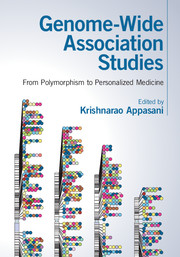Book contents
- Frontmatter
- Dedication
- Contents
- List of contributors
- Forewords
- Preface
- List of abbreviations
- Part I Genome-wide association studies
- Part II Genome-wide studies in disease biology
- Part III Single nucleotide polymorphisms, copy number variants, haplotypes and eQTLs
- Part IV Next-generation sequencing technology and pharmaco-genomics
- 15 Next-generation sequencing for rare diseases
- 16 Next-generation sequencing for complex disorders
- 17 Chromosomal breakpoints in breast cancer co-localize with differentially methylated regions
- 18 Signaling network analysis of genomic alterations predicts breast cancer drug targets
- 19 Pharmacogenetic studies in pediatric acute myeloid leukemia
- 20 Pharmaco-genomics of antiretroviral drugs
- Part V Population genetics and personalized medicine
- Index
- Plate section
- References
16 - Next-generation sequencing for complex disorders
from Part IV - Next-generation sequencing technology and pharmaco-genomics
Published online by Cambridge University Press: 18 December 2015
- Frontmatter
- Dedication
- Contents
- List of contributors
- Forewords
- Preface
- List of abbreviations
- Part I Genome-wide association studies
- Part II Genome-wide studies in disease biology
- Part III Single nucleotide polymorphisms, copy number variants, haplotypes and eQTLs
- Part IV Next-generation sequencing technology and pharmaco-genomics
- 15 Next-generation sequencing for rare diseases
- 16 Next-generation sequencing for complex disorders
- 17 Chromosomal breakpoints in breast cancer co-localize with differentially methylated regions
- 18 Signaling network analysis of genomic alterations predicts breast cancer drug targets
- 19 Pharmacogenetic studies in pediatric acute myeloid leukemia
- 20 Pharmaco-genomics of antiretroviral drugs
- Part V Population genetics and personalized medicine
- Index
- Plate section
- References
Summary
Complex diseases and GWAS
Complex or multifactorial diseases are, by definition, determined by a number of genetic and environmental factors. Unlike the mutations that underlie Mendelian diseases, which involve single mutations with strong phenotypic effects, complex diseases are believed to be caused by multiple genetic variants along the genome, implying that each of them has a weak effect on its own. The most common strategy for identifying such risk alleles has been through association studies, in which allele frequencies from patients and controls were initially compared in candidate genes, although now this is usually done on a genome-wide scale, in the so-called genome-wide association studies (GWASs). In the last years, GWASs have successfully identified hundreds of common risk variants associated with the most common human diseases such as diabetes, Alzheimer's, Parkinson's, Crohn's disease, schizophrenia, and various types of cancer. This notable achievement was not reached until it became possible to compare, in large cohorts of patients and controls (more recently in the range of tens of thousands individuals), the allele frequencies at several hundred thousand single nucleotide polymorphisms (SNPs) which are assayed on arrays that are able to capture the most common variations in the human genome (usually those with minor allele frequencies, or MAF, > 5%).
Although GWASs have remarkably facilitated insights into understanding complex disease, it is clearly recognized that most of the disease-associated SNPs identified in GWASs usually imply a very small increase in risk and explain only a modest fraction of the genetic component (commonly referred as heritability) of most complex traits (Manolio et al., 2009). Many factors have been suggested to explain such “missing heritability”: the existence of much larger numbers of still-undetected small-effect variants; the possible involvement of structural variants, inadequately picked up by SNP arrays; potential gene–gene interactions; and heritability overestimates due to gene–environment correlations. GWASs may have also partially failed because the common variant–common disease model was uncritically assumed, and rarer variants (those with MAF < 5%, and therefore not included in SNP arrays used for GWASs) with moderate to high penetrance could actually play an important role in common, complex diseases. Thanks to the development of next-generation sequencing technologies (NGS), most of the focus to find the missing heritability in complex disease is now going to the low-frequency (defined here as those in the 0.5–5% range) and rare (MAF < 0.5%) genetic variants.
- Type
- Chapter
- Information
- Genome-Wide Association StudiesFrom Polymorphism to Personalized Medicine, pp. 243 - 254Publisher: Cambridge University PressPrint publication year: 2016



